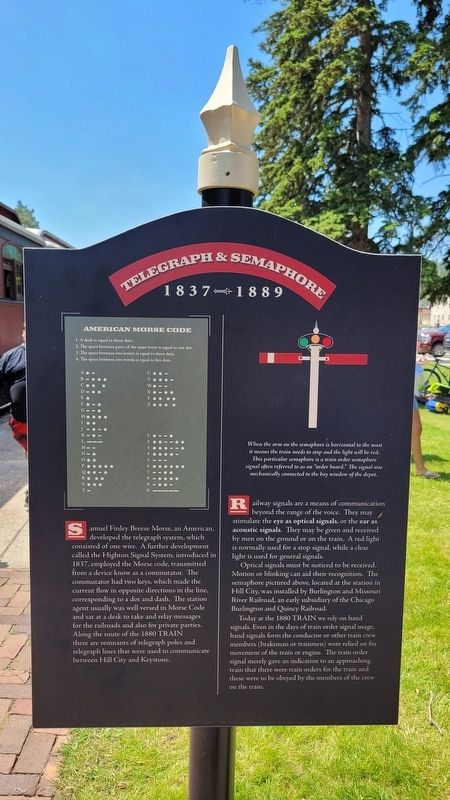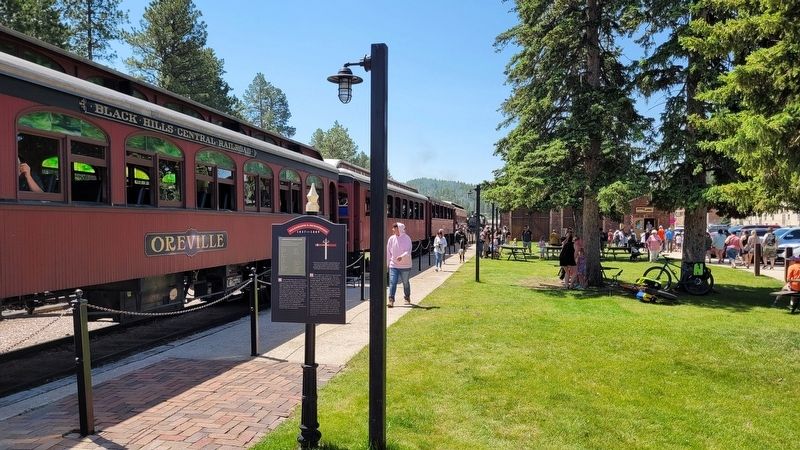Hill City in Pennington County, South Dakota — The American Midwest (Upper Plains)
Semaphore & Telegraph
1837-1889
Railway signals are a means of communication beyond the range of the voice. They may stimulate the eye as optical signals, or the ear as acoustic signals. They may be given and received by men on the ground or on the train. A red light is normally used for a stop signal, while a clear light is used for general signals.
Optical signals must be noticed to be received. Motion or blinking can aid their recognition. The semaphore pictured above, located at the station in Hill City, was installed by Burlington and Missouri River Railroad, an early subsidiary of the Chicago Burlington and Quincy Railroad.
Today at the 1880 Train we rely on hand signals. Even in the days of train order signal usage, hand signals form the conductor or other train crew members (brakeman or trainmen) were relied on for movement of the train or engine. The train order signal merely gave an indication to an approaching train that there were train orders for the train and these were to be obeyed by the members of the crew on the train.
Captions
Upper Left:
American Morse Code
1. A dash is equal to three dots.
2. The space between parts of the same letter is equal to one dot.
3. The space between two letters is equal to three dots.
4. The space between two words is equal to five dots.
Upper Right: When the arm on the semaphore is horizontal to the mast it means the train needs to stop and the light will be red. This particular semaphore is a train order semaphore signal often referred to as an "order board." The signal was mechanically connected to the bay window of the depot.
Erected by 1880 Train - Hill City Depot.
Topics. This historical marker is listed in these topic lists: Communications • Railroads & Streetcars. A significant historical year for this entry is 1837.
Location. 43° 55.921′ N, 103° 34.404′ W. Marker is in Hill City, South Dakota
, in Pennington County. Marker can be reached from the intersection of Railroad Avenue and Elm Street. The marker is located at the central section of the 1880 Train - Hill City Depot. Touch for map. Marker is at or near this postal address: 222 Railroad Avenue, Hill City SD 57745, United States of America. Touch for directions.
Other nearby markers. At least 8 other markers are within walking distance of this marker. Hill City Depot (a few steps from this marker); The Black Hills Central Railroad (within shouting distance of this marker); BNSF Railroad Signal (within shouting distance of this marker); The Steam Locomotive (about 400 feet away, measured in a direct line); Black Hills Central Railroad's Famous Engine #7 (about 700 feet away); Von Woehrman Building (about 800 feet away); Hill City (approx. 0.2 miles away); The Little White Church (approx. 0.3 miles away). Touch for a list and map of all markers in Hill City.
Also see . . .
1. 1880 Train History. (Submitted on July 25, 2022, by James Hulse of Medina, Texas.)
2. Samuel Morse. Wikipedia (Submitted on July 25, 2022, by James Hulse of Medina, Texas.)
Credits. This page was last revised on July 25, 2022. It was originally submitted on July 25, 2022, by James Hulse of Medina, Texas. This page has been viewed 91 times since then and 13 times this year. Photos: 1, 2. submitted on July 25, 2022, by James Hulse of Medina, Texas.

